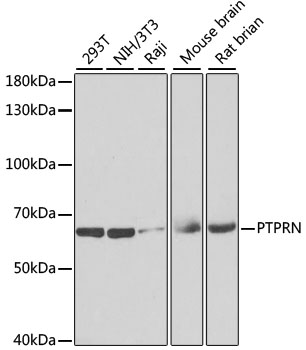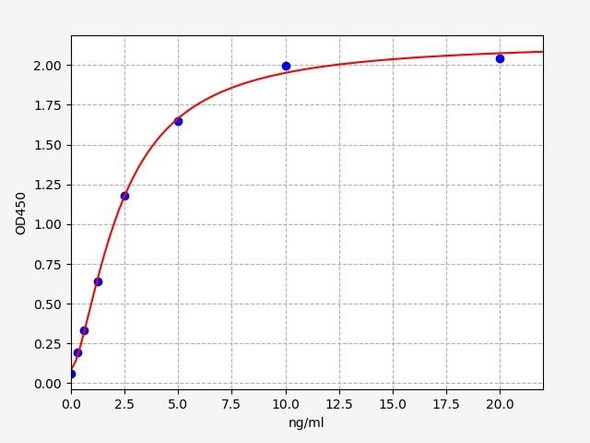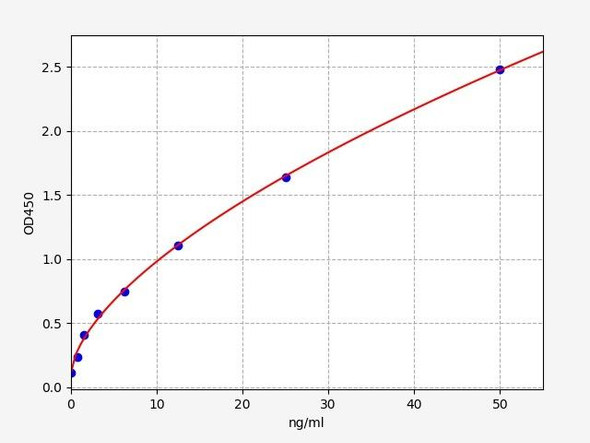Epigenetics & Nuclear Signaling Antibodies 4
Anti-PTPRN Antibody (CAB6401)
- SKU:
- CAB6401
- Product Type:
- Antibody
- Reactivity:
- Human
- Reactivity:
- Mouse
- Reactivity:
- Rat
- Host Species:
- Rabbit
- Isotype:
- IgG
- Antibody Type:
- Polyclonal Antibody
- Research Area:
- Epigenetics and Nuclear Signaling
Description
| Antibody Name: | Anti-PTPRN Antibody |
| Antibody SKU: | CAB6401 |
| Antibody Size: | 20uL, 50uL, 100uL |
| Application: | WB IHC |
| Reactivity: | Human, Mouse, Rat |
| Host Species: | Rabbit |
| Immunogen: | Recombinant fusion protein containing a sequence corresponding to amino acids 600-889 of human PTPRN (NP_001186693.1). |
| Application: | WB IHC |
| Recommended Dilution: | WB 1:500 - 1:2000 IHC 1:50 - 1:100 |
| Reactivity: | Human, Mouse, Rat |
| Positive Samples: | 293T, NIH/3T3, Raji, Mouse brain, Rat brian |
| Immunogen: | Recombinant fusion protein containing a sequence corresponding to amino acids 600-889 of human PTPRN (NP_001186693.1). |
| Purification Method: | Affinity purification |
| Storage Buffer: | Store at -20'C. Avoid freeze / thaw cycles. Buffer: PBS with 0.02% sodium azide, 50% glycerol, pH7.3. |
| Isotype: | IgG |
| Sequence: | STGH MILA YMED HLRN RDRL AKEW QALC AYQA EPNT CATA QGEG NIKK NRHP DFLP YDHA RIKL KVES SPSR SDYI NASP IIEH DPRM PAYI ATQG PLSH TIAD FWQM VWES GCTV IVML TPLV EDGV KQCD RYWP DEGA SLYH VYEV NLVS EHIW CEDF LVRS FYLK NVQT QETR TLTQ FHFL SWPA EGTP ASTR PLLD FRRK VNKC YRGR SCPI IVHC SDGA GRTG TYIL IDMV LNRM AKGV KEID IAAT LEHV RDQR PGLV RSKD QFEF ALTA VAEE VNAI LKAL PQ |
| Gene ID: | 5798 |
| Uniprot: | Q16849 |
| Cellular Location: | Cell junction, Cell membrane, Cell projection, Cytoplasmic vesicle, Endosome, Membrane, Perikaryon, Single-pass type I membrane protein, axon, secretory vesicle membrane, synapse |
| Calculated MW: | 96kDa/102kDa/105kDa |
| Observed MW: | 66kDa |
| Synonyms: | PTPRN, IA-2, IA-2/PTP, IA2, ICA512, R-PTP-N |
| Background: | The protein encoded by this gene is a member of the protein tyrosine phosphatase (PTP) family. PTPs are known to be signaling molecules that regulate a variety of cellular processes including cell growth, differentiation, mitotic cycle, and oncogenic transformation. This PTP possesses an extracellular region, a single transmembrane region, and a single catalytic domain, and thus represents a receptor-type PTP. This PTP was found to be an autoantigen that is reactive with insulin-dependent diabetes mellitus (IDDM) patient sera, and thus may be a potential target of autoimmunity in diabetes mellitus. Alternate splicing results in multiple transcript variants. |
| UniProt Protein Function: | PTPRN: Implicated in neuroendocrine secretory processes. May be involved in processes specific for neurosecretory granules, such as their biogenesis, trafficking or regulated exocytosis or may have a general role in neuroendocrine functions. Seems to lack intrinsic enzyme activity. May play a role in the regulation of secretory granules via its interaction with SNTB2. Belongs to the protein-tyrosine phosphatase family. Receptor class 8 subfamily. 2 isoforms of the human protein are produced by alternative splicing. |
| UniProt Protein Details: | Protein type:Membrane protein, integral; Receptor protein phosphatase, tyrosine; Motility/polarity/chemotaxis Chromosomal Location of Human Ortholog: 2q35-q36.1 Cellular Component: integral to membrane Molecular Function:GTPase binding; protein binding; spectrin binding; protein tyrosine phosphatase activity Biological Process: response to reactive oxygen species; response to cAMP; response to estrogen stimulus; insulin secretion; cytokine and chemokine mediated signaling pathway; response to glucose stimulus; protein amino acid dephosphorylation; response to insulin stimulus |
| NCBI Summary: | The protein encoded by this gene is a member of the protein tyrosine phosphatase (PTP) family. PTPs are known to be signaling molecules that regulate a variety of cellular processes including cell growth, differentiation, mitotic cycle, and oncogenic transformation. This PTP possesses an extracellular region, a single transmembrane region, and a single catalytic domain, and thus represents a receptor-type PTP. This PTP was found to be an autoantigen that is reactive with insulin-dependent diabetes mellitus (IDDM) patient sera, and thus may be a potential target of autoimmunity in diabetes mellitus. Alternate splicing results in multiple transcript variants.[provided by RefSeq, Dec 2010] |
| UniProt Code: | Q16849 |
| NCBI GenInfo Identifier: | 2499754 |
| NCBI Gene ID: | 5798 |
| NCBI Accession: | Q16849.1 |
| UniProt Secondary Accession: | Q16849,Q08319, Q53QD6, Q6NSL1, B4DK12, F5GZS3, |
| UniProt Related Accession: | Q16849 |
| Molecular Weight: | 979 |
| NCBI Full Name: | Receptor-type tyrosine-protein phosphatase-like N |
| NCBI Synonym Full Names: | protein tyrosine phosphatase, receptor type, N |
| NCBI Official Symbol: | PTPRN |
| NCBI Official Synonym Symbols: | IA2; IA-2; ICA512; R-PTP-N; IA-2/PTP |
| NCBI Protein Information: | receptor-type tyrosine-protein phosphatase-like N; ICA 512; PTP IA-2; islet cell antigen 2; islet cell antigen 512; islet cell autoantigen 3; protein tyrosine phosphatase-like N |
| UniProt Protein Name: | Receptor-type tyrosine-protein phosphatase-like N |
| UniProt Synonym Protein Names: | Islet cell antigen 512; ICA 512; Islet cell autoantigen 3; PTP IA-2 |
| Protein Family: | Receptor-type tyrosine-protein phosphatase |
| UniProt Gene Name: | PTPRN |
| UniProt Entry Name: | PTPRN_HUMAN |
View AllClose







